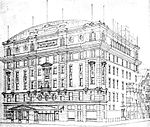Touro College of Osteopathic Medicine
The Touro College of Osteopathic Medicine (TouroCOM) is a private medical school with a main campus in the neighborhood of Central Harlem in New York City and an additional campus in Middletown, New York. It is a division of Touro College and University System.The college's inaugural class graduated in 2011. It was the first medical school to open in New York State in nearly 30 years and is the first osteopathic medical school with a special emphasis on training minority doctors. TouroCOM currently has a student body of about 1080 students.TouroCOM has a stated goal of particularly identifying and recruiting students willing to make a commitment to practice in underserved communities such as Harlem and Middletown. The neighborhood has been designated by the federal government as underserved by medical professionals. Community service events such as free health counseling, screenings, and flu shots are offered to local residents by students and faculty several times a year.
Excerpt from the Wikipedia article Touro College of Osteopathic Medicine (License: CC BY-SA 3.0, Authors).Touro College of Osteopathic Medicine
West 125th Street, New York Manhattan
Geographical coordinates (GPS) Address Nearby Places Show on map
Geographical coordinates (GPS)
| Latitude | Longitude |
|---|---|
| N 40.80942 ° | E -73.94965 ° |
Address
Platinum Jewelry of Harlem
West 125th Street 236
10027 New York, Manhattan
New York, United States
Open on Google Maps







